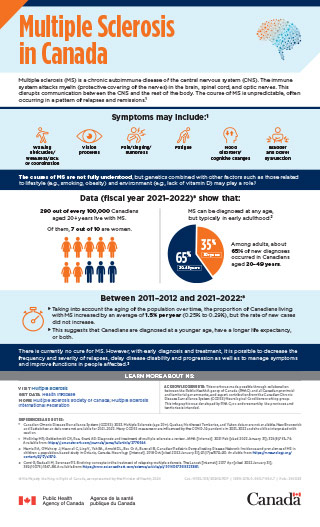Multiple Sclerosis in Canada

Download the alternate format
(PDF Version - 156 K)
Organization: Public Health Agency of Canada
Date: May 30, 2018
Multiple sclerosis (MS) is a disease of the central nervous system (CNS). The immune system attacks myelin (protective covering of the nerves) in the brain, spinal cord, and optic nerves, which disrupts communication between the CNS and the rest of the body.
MS is unpredictable, often occurring in a pattern of relapses and remissions. There is currently no cure for MS, but treatments are available to decrease the frequency and severity of relapses and to ease MS symptoms.
Symptoms may include
- Walking difficulties
- Vision problems
- Weakness or clumsiness
- Abnormal sensation (e.g. tingling or numbness)
- Fatigue
- Mood and cognitive changes
- Pain
MS causes are not fully understood, but genetics combined with other factors related with lifestyle and environment, for example, may play a role.
New estimates (fiscal year 2014–2015) show that in Canadians aged 20+
- Over 77,000 live with MS; almost ¾ are women.
- On average, 8 women and 3 men are diagnosed with MS every day.
- About 60% of adults newly diagnosed with MS are 20-49 years old.
Between 2003–2004 and 2014–2015
- The proportion of Canadians living with MS increased by 1/3, but the rate of new cases did not increase.
- Overall, Canadians with MS live longer now than before.
Learn more about MS in Canada
- VISIT Canada.ca and search ‘Multiple sclerosis’
- READ Mapping connections - An understanding of neurological conditions in Canada
- GET DATA Public Health Infobase
- FOLLOW US @GovCanHealth
- LIKE US @HealthyCdns
- MORE Multiple Sclerosis Society of Canada; Multiple Sclerosis International Federation
Data source: Canadian Chronic Disease Surveillance System (CCDSS), March 2018. Rates do not include data from Quebec and Yukon. Prevalence and incidence numbers for Quebec and Yukon were estimated based on Canadian rates and added to the Canadian total. CCDSS data are based on health administrative data and capture people with diagnosed MS who had contact with the health system during the data collection period. This may underestimate the total number of people diagnosed with MS during a lifetime. Acknowledgements: This work was made possible through collaboration between PHAC and all Canadian provincial and territorial governments, and expert contribution from the CCDSS Neurological Conditions Working Group. This infographic was developed by PHAC; no endorsement by the provinces and territories should be inferred.
Page details
- Date modified: